Engineering: My co-teacher and I attended a workshop last year called “The E in STEM – Exploring Engineering in Early Childhood” done by the folks from Kodo toys (www.KodoKids.com). They said Engineering is all about problem-solving – you find a problem, you work toward a solution. Play is when kids make up problems to solve and call that fun. The focus of play is on the process – once you’ve solved one problem, you set up a new, more complicated one to solve.
The final week in our Engineering unit at Family Inventor’s Lab was Contraptions and Rube Goldbergs: Designing Interactions between Simple Machines. It was all about taking tools and concepts from our simple machines unit and our engineering unit and combining them in fun and playful ways – a Rube Goldberg can combine several simple machines, but instead of making work easier to do, as Simple Machines should, Rubes are all about making a really simple task more complicated.
This was a day about Tinkering where kids were encouraged to build something, test it, adjust it, test it again, say “hey I wonder what would happen if we added X”, add X and test it again. To read a great example of the process of designing a Rube Goldberg to pour a bowl of cereal, see this post on Hands on As We Grow.
Activities for Tinkering with Chain Reactions and Contraptions
Challenge of the Day / The Launch Table: On one table, we set up a target to aim for, pompoms for ammunition, and then ramps, levers and fulcrums, corks, dowels, blocks and plastic spoons for launch equipment. (In past classes, we had explored Inclined Planes, Levers, and Catapults.) Kids were just shown the target and given a couple suggestions for what to try, and then left to play. I listened in on a couple of parents giving great guidance and asking great questions to extend their child’s learning. “What do you think will happen if…” “Hmm… that’s not heavy enough… can you find something heavier?” “OK, you got great height with that launch, but how can we work on accuracy – aiming it toward that target?” “If you roll this dowel down the ramp, would it hit the target?” “You’ve got great accuracy when you aim from up close – what if we launch from further away?”
Ball Launcher: We brought our scarf cannon, but used it for launching balls (soft plastic balls like you would find in a ball pit, and Styrofoam balls.) Kids played “golf” with it, where the goal was to aim the tube so that when the ball shot out, it would roll through the tunnel blocks. They also did a variety of other experiments… a fun one would be to tie a hoop in the air and try to shoot the balls through it.
Ramps, Tunnels, and Balls: We have a Discovery Ramp kit from Kodo kids that allowed the kids to build some fun ramp projects.
Duplo Simple Machines kit: In the other weeks of our engineering unit, we would put out materials and instructions for a single project to do with Duplos. The goal those weeks was to give children practice following directions to achieve a pre-designed result. This week we put out the full Simple Machines kit for them to do free designing with.
DIY Marble Run: We had our ball wall there for kids to play with.
Marble Run: We also had this marble run, which is great, and could also be used as part of a larger Rube Goldberg series of actions, as seen in the video on this Tinkerlab page: http://tinkerlab.com/engineering-kids-rube-goldberg-machine/.
Train: We have a Domino Train which sets up perfect chains of dominos to knock over.
Domino Runs: We had dominos so children could set up chains of dominos to knock over. It’s fun to also include some “triggers” for Domino chains – things you can use to push over that first Domino in the chain. Examples we had were our Conveyor Belt from inclined planes week, our Wrecking Ball and pull-back car from Towers week, and a tube that you could aim at the dominoes then roll a marble through. It’s also fun to include some “goals”, such as a target to hit – we used a Duplo tower to hang a musical triangle in so the Domino chain could ring the bell at the end. This is a Rube built by one of the dads:
Pulleys: There’s all sorts of stuff you can do with pulleys and Rubes, but we just didn’t have enough time to use all our ideas. But, if you have a more extended time, be sure to include pulleys! (Read about our Simple Machines unit on pulleys.)
Crafts and Play
Button Spinners / Whirligigs: (Original idea from (Housing a Forest and Play, Eat, Grow) Prep: These are traditionally done with large buttons. We wanted a bigger toy, so we used old CD’s – we glued a button in the center with Tacky Glue. You can also use any metal or plastic disc (baby food jar lids, margarine tub lids, or cardboard disks) and just drill two holes near the middle.
In class, kids decorate them with Sharpies, then ran a string through two holes. Kids could then put the fingers of one hand through one end of the string loop and the fingers of the other hand in the other end. They wind it up until the string is twisted tight, then stop twirling, hold the strings taut, and watch it spin. See a video tutorial at: www.youtube.com/watch?v=-QMmfDhrZxg and here’s more on how to spin it: www.youtube.com/watch?v=-4Jhc-tme9U.
Depending on the materials used, whirligigs can make a buzzing sound when they spin, especially if the outside edge of the circle is cut in a sawtooth pattern. See an article on the history of these at johnwinter.net.
Researchers have now realized this simple technology can be used as a cheap, electricity-free centrifuge. By playing around with the disc size, hole positions, type of string and other variables, they have developed one that can spin at up to 125,000 revolutions per minute – the fastest rotational speed achieved by a human powered device. And fast enough to separate cells in blood samples for low cost diagnostic testing by health care workers in the lowest resource places in the world. www.theatlantic.com/science/archive/2017/01/button-spinner-health-care/512549/
Craft: Climbing Critters: Make and Takes had a great post on how to make simple “climbing critters” – cardstock animals you mount on a loop of string – when you pull on the ends of the string, they “climb.” I made up a poster with instructions.
Mouse Trap: We set out the game Mouse Trap – a fun pre-made Rube Goldberg.
Water table: We put water wheels in the water table.
Circle
Intro to Concept: At opening circle, we talked about Rube Goldberg and showed one of his books of illustrations (Rube Goldberg: Inventions!), and we explained the idea of putting together a ridiculously complicated series of mechanical actions to accomplish a simple mechanical task. For example: instead of just turning on a light switch, you set up a ramp and a pulley, where you roll a ball down the ramp, it falls into a basket which pulls the pulley, which turns on the light. Why not just turn on the light switch? Because it’s more fun this way.
My co-teacher had built this sample Rube to demonstrate during circle. The design was based on this video: https://www.youtube.com/watch?v=0Ye7iAIPhmg
Sometimes the demo works, and sometimes it doesn’t, and everyone laughs together, then we re-build it and try again. It’s a good way to talk about the fact that sometimes things don’t work right the first time – it doesn’t mean we’ve failed and it will never work. It just means it doesn’t work YET and we might need to work a little harder on it. (Last year, my parent education session this day was on “Willingness to Fail is the Key to Success” on the Growth Based mindset, intentionally matched up with the kids’ theme of the day.)
After circle, we let the kids play with the Rube, and there was another peg board and supplies next to it to encourage kids to build their own
Books: We read the book Lights Out, which tells of a piggy who needs to figure out how to turn off his lights from his bed after he falls asleep. It’s a wordless book that shows a VERY complex series of contraptions – fun to read if you add sound effects – “thwack” goes the broom on the seesaw; boingeduh-boingeduh-boing goes the ball down the stairs.
At closing circle, we read Mechanimals about a farmer who builds mechanical animals, including a pig that flies. Some books we’ve read for previous themes that could tie in to contraptions are: Awesome Dawson
and Wendel’s Workshop
from Robot week, Violet the Pilot
and Rosie Revere, Engineer
from Wind week and The Most Magnificent Thing
. You could also include Dumpster Diver – described in my list of books about Inventors. (These are all affiliate links for learning more – books can be purchased from Amazon, or you can get them from the library.) If you know of a great book about a kid building contraptions or Rube Goldbergs, tell me about it in the comments!
Song – we didn’t find a song we loved for this week – best idea was Button Factory, which turns the child into a “kinetic sculpture” of movement. (Find videos on YouTube if you don’t know the tune.)
Hey! My name is Joe. And I work in a button factory
One day my boss came up to me.
He said “Jo, are you busy?” I said,”No”
He said “push this button with your right hand”
Apps and Videos
A great preview for this class would be to go to http://josephsmachines.com/ and watch his video called Joseph on Sesame Street – about Kinetic Art. Then watch any of his other videos! Also, on YouTube, just do a search for “domino chain reactions” or “Rube Goldberg machines.”, and you’ll find PLENTY of videos to entertain you.
A fun way to prepare a child for this class or to review the ideas could be to explore a “contraptions” app. This is completely optional!!!! Parents who don’t like their child to do screen time, can feel free to skip this idea. My favorite is Inventioneers. Pettson’s Inventions,
by the same company, is also quite good. Bad Piggies,
from the Angry Birds Universe, also is a contraptions app. If your child ONLY does the app and only builds virtual contraptions, I think that there’s limited learning potential here. But, if they work with real, physical objects hands-on, then explore in an app, then return to the physical objects, I think it can be a nice tie-in.
Inventioneers: This app is available on Android and IOS. It is free in the Kindle app store. It’s all about Rube Goldberg type processes – you drop an apple on the character’s head, he turns on his blower, which turns a fan, which moves a gear, which knocks the basketball off the platform onto the seesaw and into the basket.
A 6 or 7 year old might be able to play it alone if an adult played the first few levels with them to give them the basic concept. A 4 or 5 year old can enjoy watching an adult play it. You usually don’t get the answer right on the first try – you set up part of the process, press play to test it, adjust it, test it again, set up the next part of the process, test that, adjust it, and so on. Talk it all through with the child. Tell them what you’re trying and why. Ask them why something didn’t work and what you can do differently. It’s definitely a learning process which requires lots of tinkering.
More Ideas
If you want to play more with this idea, it’s easy! Just put out loose parts, like blocks, bells, pulleys, dominoes, marbles and more. Give your child a challenge to complete. Encourage building a step at a time. For example, if the goal is to ring a bell, maybe they first build a domino chain to ring it. Then they add a wrecking ball to trigger the dominos. Then they add something to bump the wrecking ball to get it started and so on.
I’ve pinned several ideas here: www.pinterest.com/bcparented/preschool-rube-goldbergs/
The best discussions on the topic are: Rube Goldberg machine on Tinkerlab, and Gadgets and Contraptions at Science World. Enjoy!
Someday, I’d love to try building some automata to share in class. Learn about Automata at Exploratorium.

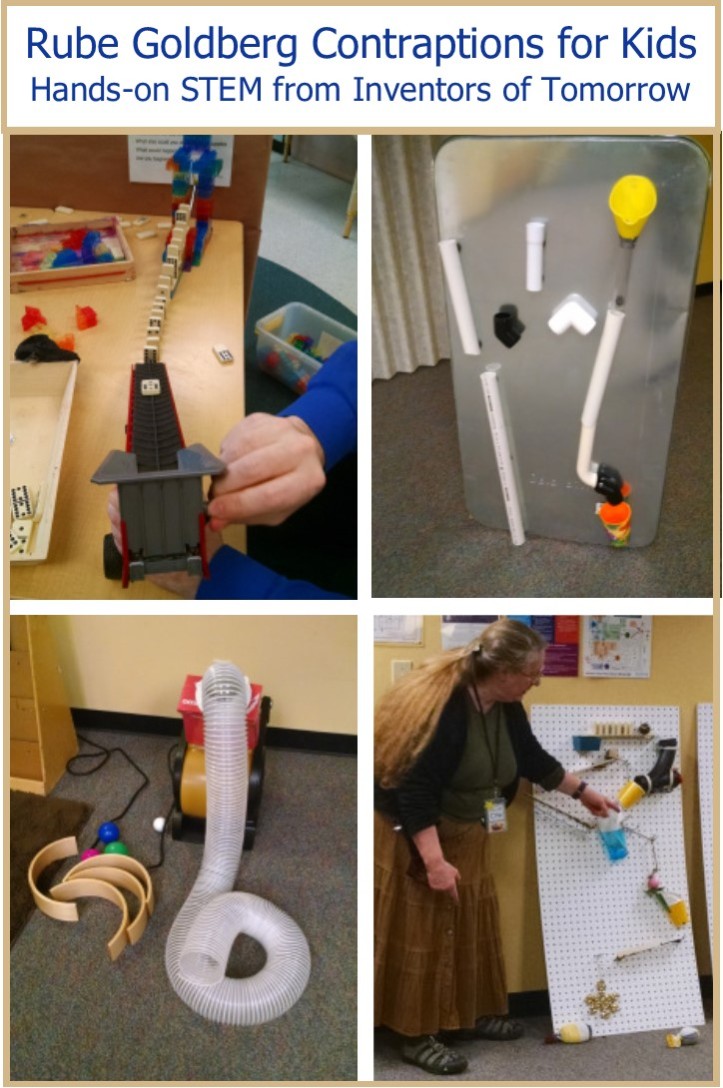
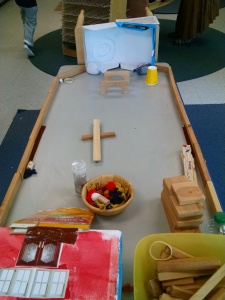
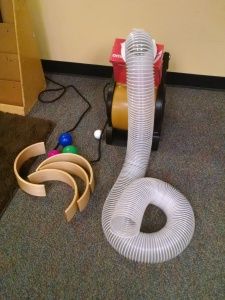
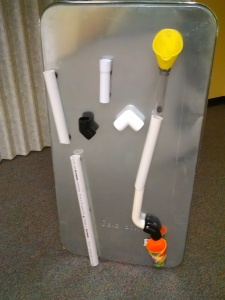
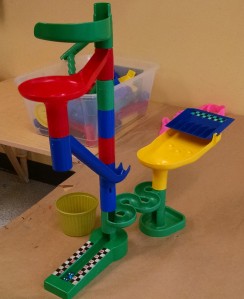
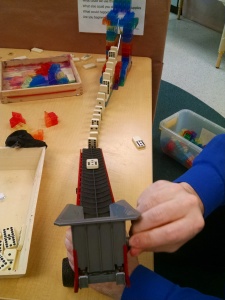

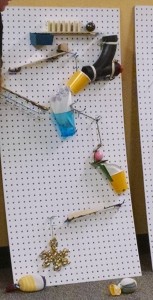
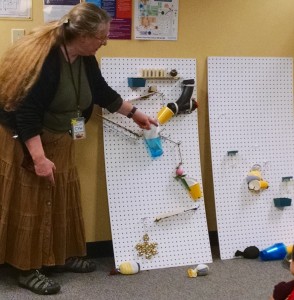
[…] Contraptions […]
LikeLike
[…] Set up domino chains and knock them down or create other Rube Goldbergs. […]
LikeLike
[…] Building: Towers, Bridges & Tunnels, If I Built a House, Contraptions and Rube Goldbergs […]
LikeLike
[…] Theme: Contraptions and Rube Goldberg Devices […]
LikeLike
[…] Theme: Contraptions and Rube Goldberg Devices […]
LikeLike
[…] Contraptions – Roller Coaster Challenge and Mouse Trap […]
LikeLike
[…] Tool of the Week: What new tool will they use? (As a STEM class, I think of the Technology part for this age group as learning to use a very wide variety of tools – this builds fine motor skills, but also builds a knowledge repertoire, so when they’re faced with future problem-solving projects, they have ideas for what tools they could employ. We’ve used everything from potato mashers to screwdrivers, egg beaters to magnets, wiring circuits to button spinners.) […]
LikeLike
[…] Victorian toy, where there are two images on two sides of a card. It is mounted on a string (like a button spinner) and when it spins, showing first one side, then the next, they seem to spin together to create a […]
LikeLike
[…] Rube Goldbergs & Contraptions. Use a kitchen gadget to prepare something: like an apple slicer, a hard-boiled egg slicer, an ice cream scoop with the lever that releases the ice cream, a veggie spiralizer, a pasta maker, a cheese grater, etc. […]
LikeLike
[…] – set up a “launch zone” with various bars, fulcrums and things to launch (e.g. pompoms) – show the basics of […]
LikeLike
[…] a processor) but it’s such a great project we’re keeping it – just moving it to Contraptions […]
LikeLike
[…] Electricity, Ways to Build Tall Structures and Strong Structures, Building Houses and Cars and Contraptions. We begin the unit by discussing the engineering […]
LikeLike
[…] Make a button spinner. Run yarn through the holes in a button, spin it to wind it up, then hold it taut and watch it spin. […]
LikeLike
[…] are three new books we’ve added to our week when we talk about Contraptions and Rube Goldbergs (one of the final sessions of our Engineering unit in my class for 3 to 6 year […]
LikeLike
[…] – set up a “launch zone” with various bars, fulcrums and things to launch (e.g. pompoms) – show the basics of […]
LikeLike
[…] here for more ideas for fun Contraptions activities for kids age 3 – 6. That post includes book […]
LikeLike
[…] a Victorian toy, where there are two images mounted back to back. It is mounted on a string (like a button spinner) and when it spins, showing first one side, then the next, they seem to spin together to create a […]
LikeLike
[…] Contraptions – Roller Coaster Challenge and Mouse Trap […]
LikeLike
[…] ideas related to push and pull, but I think it’s better for learning about chain reactions or Rube Goldbergs. The other books shown in the image are also all good solid non-fiction books on this topic for […]
LikeLike